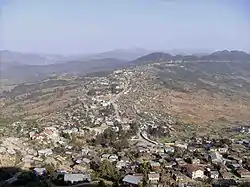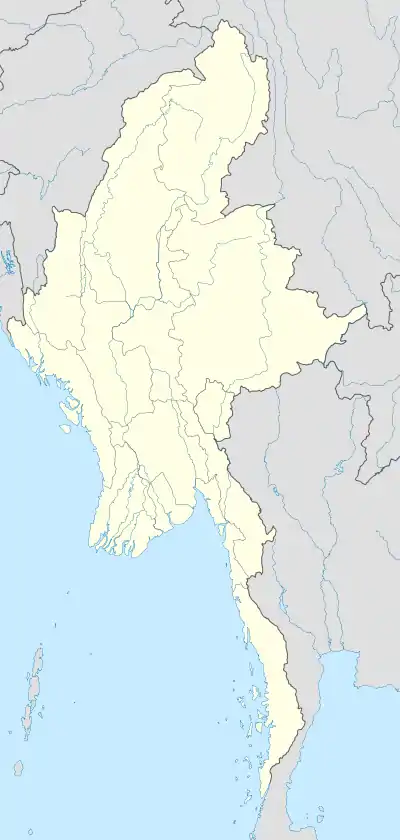Hakha
Hakha (Burmese: ဟားခါးမြို့; MLCTS: ha: hka: mrui., pronounced [hákʰá mjo̰]; formerly rendered Haka[2][3]) is the capital of Chin State in Myanmar.
Hakha
Haka | |
|---|---|
 Hakha | |
 Hakha Location in Burma | |
| Coordinates: 22°38′43.9476″N 93°36′18.129″E | |
| Country | |
| State | |
| District | Hakha District |
| Township | Hakha Township |
| Area | |
| • Total | 12.50 sq mi (32.4 km2) |
| Elevation | 6,128 ft (1,867 m) |
| Population | 29,800 |
| • Ethnicities | Chin people and Burmese Mizos |
| Time zone | UTC+6:30 (MST) |

Hakha is located in the northeast of Chin State, with a total area of about 12.50 square miles (32.4 km2). The city of Hakha is more than 1,867 metres (6,125 ft) above sea level, founded on a small highland plateau. Although it is relatively small in land area, it is the largest city of Chin State, as well as its capital city, with the plateau significantly larger than that of other towns in Chin State. It is estimated that Hakha has enough land and full capacity to extend to as ten times its current township area.
As Chin State is quite hilly, Hakha is built on the slope of a large mountain, in a U shape. There is only one main road running along the middle of the city, in a curved U, and the whole city is built along this road. Another road runs from the middle of the city, for a short while, forming the foot of U. Hakha is in the center of Chin State and it is connected with Thantlang, Falam, Gangaw, and Matupi by truck roads.[4]
History
Hakha was founded around 1400 by the Lai ethnic group. The area was ruled by local chiefs for many generations and it consisted of more than 600 houses when the British troops arrived in Hakha in 1889.
The British occupied Hakha on 19 January 1890, as part of their operation to "subdue the wild tribes" in the Arakan Hills Division, as the area was then called. The British government later established a sub-divisional office and Hakha became a town a few years later.
The first American Baptist missionary couple, Arthur Carson (1860-1908) and his wife Laura (1858-1942) who arrived in Hakha on March 15, 1899 opened a mission station. Later other missionaries joined them and did extensive mission works throughout the Chin Hills and converted most of the Northern Chin State to Christianity within a century. This missionary work brought education, development, social and economic changes, and health improvement to the Chin people. The main contribution to language education was by Chester Strait of Wisconsin (1893-1985) who opened the Chin Hills Bible School in 1928 with thirteen students - four from the Tedim area of the Zomi people, four from Falam and five from the Hakha areas of the Laimi, another branch of the Chin people. Although the teaching was in the Lai language after six months all students were able to write their final exam in the language.[5]
During the Second World War, Hakha was captured by Japanese troops on 11 November 1943; it was later recaptured by British troops.
When Burma gained independence from British control in 1948, Hakha became an important city as the center for one of the subdivisions in the Chin Special Division, of which Falam was the capital at that time. The Chin Special Division was abolished reformed as the Chin State in 1974, at which time Hakha became the capital of the Chin State. That brought an influx of government workers, and housing development and extension of the city. Hakha eventually became the largest city in the Chin State with about 20,000 people.[6] Hakha was part of the newly formed district:Hakha District on 1 June 2012.
Geography and climate
The city is 6,120 feet (1,870 m) above sea level and it lies at the foot of Rung Tlang (Mt. Rung), which is about 7,543 feet (2,299 m) high, and is one of the most famous and beautiful mountain peaks in the Chin State.
Hakha features a subtropical highland climate (Cwb) under the Köppen climate classification. Because it is located in the outer tropics, Hakha experiences three seasons – cool, warm and rainy. Because of the high altitude, the temperatures are always much cooler than those in the plains.
During the cool season months, the days are pleasant to warm but the mornings are quite cold. Sometimes, the temperature drops to as low as −2 °C or 28.4 °F. It is also very windy in winter. The whole city is foggy in the morning and in the evening. During the month of January 2009 there was a cold wave that hit Burma. It was reported that temperatures dropped to 0 °C or 32 °F.[7]
The total rainfall is about 72 inches or 1,800 millimetres every year.
The Burmese meteorology department has issued daily weather reports since 1988, but does not issue warnings of predicted heat waves or cold snaps.[8]
| Climate data for Hakha (1991–2020) | |||||||||||||
|---|---|---|---|---|---|---|---|---|---|---|---|---|---|
| Month | Jan | Feb | Mar | Apr | May | Jun | Jul | Aug | Sep | Oct | Nov | Dec | Year |
| Record high °C (°F) | 24.9 (76.8) |
26.4 (79.5) |
29.5 (85.1) |
32.5 (90.5) |
30.0 (86.0) |
30.0 (86.0) |
30.0 (86.0) |
28.0 (82.4) |
26.6 (79.9) |
27.0 (80.6) |
26.2 (79.2) |
24.7 (76.5) |
32.5 (90.5) |
| Average high °C (°F) | 18.7 (65.7) |
20.6 (69.1) |
23.2 (73.8) |
25.0 (77.0) |
24.4 (75.9) |
23.2 (73.8) |
22.4 (72.3) |
22.1 (71.8) |
22.2 (72.0) |
21.5 (70.7) |
19.8 (67.6) |
18.5 (65.3) |
21.8 (71.2) |
| Daily mean °C (°F) | 10.5 (50.9) |
12.5 (54.5) |
15.7 (60.3) |
18.1 (64.6) |
19.0 (66.2) |
19.4 (66.9) |
19.2 (66.6) |
18.9 (66.0) |
18.6 (65.5) |
17.0 (62.6) |
13.4 (56.1) |
10.6 (51.1) |
16.1 (61.0) |
| Average low °C (°F) | 2.2 (36.0) |
4.5 (40.1) |
8.3 (46.9) |
11.2 (52.2) |
13.6 (56.5) |
15.7 (60.3) |
16.0 (60.8) |
15.8 (60.4) |
15.0 (59.0) |
12.5 (54.5) |
7.0 (44.6) |
2.7 (36.9) |
10.4 (50.7) |
| Record low °C (°F) | −4.3 (24.3) |
−5.0 (23.0) |
−1.0 (30.2) |
4.6 (40.3) |
8.9 (48.0) |
10.2 (50.4) |
11.5 (52.7) |
11.0 (51.8) |
10.0 (50.0) |
3.5 (38.3) |
−3.8 (25.2) |
−4.8 (23.4) |
−5.0 (23.0) |
| Average precipitation mm (inches) | 12.1 (0.48) |
11.1 (0.44) |
27.2 (1.07) |
66.0 (2.60) |
186.9 (7.36) |
261.5 (10.30) |
335.2 (13.20) |
351.6 (13.84) |
317.1 (12.48) |
205.3 (8.08) |
37.6 (1.48) |
14.2 (0.56) |
1,825.7 (71.88) |
| Average precipitation days (≥ 1.0 mm) | 1.0 | 1.8 | 3.0 | 6.8 | 13.5 | 20.3 | 23.7 | 23.3 | 20.7 | 15.8 | 4.4 | 1.1 | 135.4 |
| Source 1: World Meteorological Organization[9] | |||||||||||||
| Source 2: Norwegian Meteorological Institute (extremes)[10] | |||||||||||||
Culture
- Chin State Cultural Museum
- Rev. Van Hre Villa (Chin Traditional House)
- Missionaries' Cemetery
- East Bungalow
- Hakha Baptist Church
Education
- Hakha College
- Hakha Educational College
- Chin Christian University
- Government Technical Institute, Hakha
Sport
The 4,000-seat Wanthu Maung Stadium, a home stadium for Chin United F.C is still under construction.[11]
References
- Census Report. The 2014 Myanmar Population and Housing Census. Vol. 2. Naypyidaw: Ministry of Immigration and Population. May 2015. p. 51.
- Google Maps (Map). Google.
- Bing Maps (Map). Microsoft and Harris Corporation Earthstar Geographics LLC.
- "Hakha". Ilovemyanmar.org. Retrieved August 19, 2010.
- Lian H. Sakhong -In Search of Chin Identity: A Study in Religion, Politics and ... Page 171 2003 "Thus, he opened the Chin Hills Bible School at Hakha on 1 May 1928 with thirteen students - four from the Tedim area of the Zomi tribe, four from Falam and five from the Hakha areas of the Laimi tribe. Although the teaching was in the Lai dialect ...
- "Myanmar: Regions, States, Major Cities & Towns - Population Statistics, Maps, Charts, Weather and Web Information".
- "'Cold Wave' likely to sweep Burma". Mizzima.com. January 15, 2009. Archived from the original on August 17, 2010. Retrieved August 19, 2010.
- http://english.dvb.no/news.php?id=2122. Retrieved February 10, 2009.
{{cite web}}: Missing or empty|title=(help) - "World Meteorological Organization Climate Normals for 1991–2020". World Meteorological Organization. Retrieved 16 October 2023.
- "Myanmar Climate Report" (PDF). Norwegian Meteorological Institute. pp. 22–24. Archived from the original (PDF) on 8 October 2018. Retrieved 28 October 2018.
- "MYANMAR-STADIUMS". www.arecar.de. Archived from the original on 2016-10-21. Retrieved 2017-10-11.
